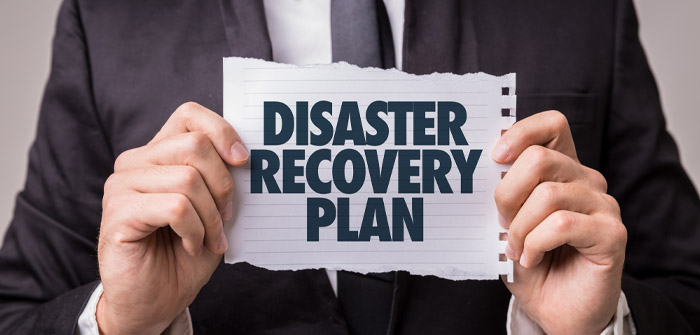Entrepreneurs may not realize the importance of having a recovery plan until they become victims of disasters. These can be cyber-attacks, calamities, natural disasters, fires, storms, or burglaries. Such disasters can affect any business. But perhaps experiencing these may not be the worst problem, as what could be worse is not having a solid recovery plan to help you navigate the aftermath. And as a result, it can be catastrophic.
One of the potential effects of such disasters is you may have to force your business to close and never reopen again. Regardless of how big or small the business scale is, it is ideal and necessary to have a plan for these emergencies.

Businessman using a computer to backup storage data Internet technology concept for backup online documentation database and digital file storage system or software,file access, doc sharing.
That said, below is an outline highlighting how you can create a disaster recovery plan, which you may consider for your business:
- Have An Emergency Plan
It’s essential to create an effective emergency preparedness plan for your business. It could serve as a guide to what steps to take next after a disaster strikes. For instance, you may include a step-by-step procedure on what to do and who to call or notify about the incident. You may also add the emergency authorities to your list.
After setting and understanding the emergency plan, you may assign and delegate the responsibilities to your employees. This way, they can be aware of their duties and what will be expected of them. You can also provide training and exercise drills to help them practice being prepared when such a disaster occurs.
- Establish A Continuity Plan
Developing a continuity plan is essential because every entrepreneur always wants to resume business after a disaster or an attack. A continuity plan may include the following:
- Recovery Plan
Ensure to document a good strategy leading your business and team members to a successful path. It’s best to include all the necessary company resources such as data backups, records, significant contracts, emergency contacts, and more. You can also conduct an overall analysis to know what you need to get back to business compared to what you have.
That said, you may need to work with the best IT services in Cincinnati or within your locality to help you eliminate frequent IT errors and help you prepare for potential risks.
- Business Impact Analysis
It’s crucial to conduct a business impact analysis to understand and compare how it can affect the business after. A data breach, for instance. Identify and analyze how much this can affect your organization, operation-wise and in terms of expenses. That way, you can be more or less prepared for how much damage this incident will incur.
- Testing
Conducting tests and assessments frequently can help you identify potential problems in your continuity plan. As such, you can easily make the necessary modifications until it can guarantee it can help you resume business operations as fast and efficient as possible after a disaster.
- Organize Crucial Contact Data
It would be wise to create a list of crucial organizations or people that you can contact after the occurrence of a disaster ahead of time. This may include your trusted suppliers, lenders, and emergency authorities. You can also take note of the details of your insurance agents and claim representatives.
Putting a list of contacts together can guarantee that reaching them will be easier, ensuring your business resumes efficiently.
- Assess The Insurance Coverage Of Your Business
Insurance coverage can be very crucial in any kind of business. Ideally, your business policy should be able to cover physical property damage or business disruption brought about by the disaster. As such, it may be recommended to assess and reevaluate your current policy once in a while to eliminate coverage gaps.
Moreover, it is always best to seek and consult professionals to discuss such concerns and help you find a policy that can suit your business well.
- Create Communication Strategies
In case of a disaster, it’s crucial that you keep all lines open to communicate with your team members, clients, and vendors about the condition of your business. Doing so can help maintain the trust between you and the other parties involved.
For one, you can contact them by phone, send them an email, or utilize technology by posting information and updates on various social media platforms.
Wrapping Up
Disasters and calamities are inevitable. It can occur anytime, and it can significantly affect any business. To guarantee business continuity and minimize possible downtime, you may need to create a recovery plan to help you protect your business from the possibility of extensive damage. The outline above can be a start to help you create a disaster recovery plan for your business.




